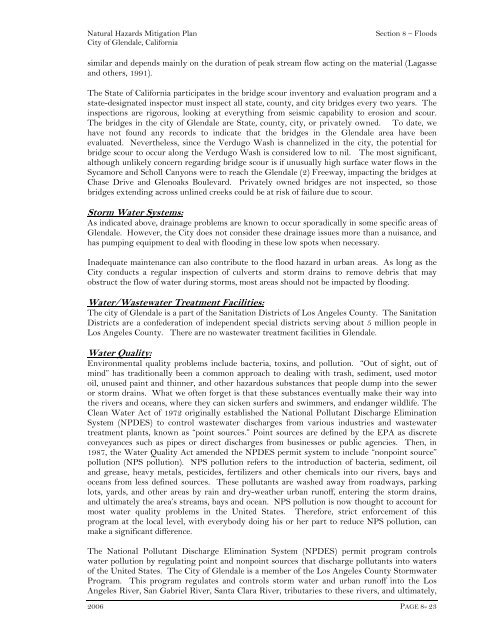Glendale (PDF) - Hazard Mitigation Web Portal - State of California
Glendale (PDF) - Hazard Mitigation Web Portal - State of California
Glendale (PDF) - Hazard Mitigation Web Portal - State of California
- No tags were found...
You also want an ePaper? Increase the reach of your titles
YUMPU automatically turns print PDFs into web optimized ePapers that Google loves.
Natural <strong>Hazard</strong>s <strong>Mitigation</strong> PlanCity <strong>of</strong> <strong>Glendale</strong>, <strong>California</strong>Section 8 – Floodssimilar and depends mainly on the duration <strong>of</strong> peak stream flow acting on the material (Lagasseand others, 1991).The <strong>State</strong> <strong>of</strong> <strong>California</strong> participates in the bridge scour inventory and evaluation program and astate-designated inspector must inspect all state, county, and city bridges every two years. Theinspections are rigorous, looking at everything from seismic capability to erosion and scour.The bridges in the city <strong>of</strong> <strong>Glendale</strong> are <strong>State</strong>, county, city, or privately owned. To date, wehave not found any records to indicate that the bridges in the <strong>Glendale</strong> area have beenevaluated. Nevertheless, since the Verdugo Wash is channelized in the city, the potential forbridge scour to occur along the Verdugo Wash is considered low to nil. The most significant,although unlikely concern regarding bridge scour is if unusually high surface water flows in theSycamore and Scholl Canyons were to reach the <strong>Glendale</strong> (2) Freeway, impacting the bridges atChase Drive and Glenoaks Boulevard. Privately owned bridges are not inspected, so thosebridges extending across unlined creeks could be at risk <strong>of</strong> failure due to scour.Storm Water Systems:As indicated above, drainage problems are known to occur sporadically in some specific areas <strong>of</strong><strong>Glendale</strong>. However, the City does not consider these drainage issues more than a nuisance, andhas pumping equipment to deal with flooding in these low spots when necessary.Inadequate maintenance can also contribute to the flood hazard in urban areas. As long as theCity conducts a regular inspection <strong>of</strong> culverts and storm drains to remove debris that mayobstruct the flow <strong>of</strong> water during storms, most areas should not be impacted by flooding.Water/Wastewater Treatment Facilities:The city <strong>of</strong> <strong>Glendale</strong> is a part <strong>of</strong> the Sanitation Districts <strong>of</strong> Los Angeles County. The SanitationDistricts are a confederation <strong>of</strong> independent special districts serving about 5 million people inLos Angeles County. There are no wastewater treatment facilities in <strong>Glendale</strong>.Water Quality:Environmental quality problems include bacteria, toxins, and pollution. “Out <strong>of</strong> sight, out <strong>of</strong>mind” has traditionally been a common approach to dealing with trash, sediment, used motoroil, unused paint and thinner, and other hazardous substances that people dump into the seweror storm drains. What we <strong>of</strong>ten forget is that these substances eventually make their way intothe rivers and oceans, where they can sicken surfers and swimmers, and endanger wildlife. TheClean Water Act <strong>of</strong> 1972 originally established the National Pollutant Discharge EliminationSystem (NPDES) to control wastewater discharges from various industries and wastewatertreatment plants, known as “point sources.” Point sources are defined by the EPA as discreteconveyances such as pipes or direct discharges from businesses or public agencies. Then, in1987, the Water Quality Act amended the NPDES permit system to include “nonpoint source”pollution (NPS pollution). NPS pollution refers to the introduction <strong>of</strong> bacteria, sediment, oiland grease, heavy metals, pesticides, fertilizers and other chemicals into our rivers, bays andoceans from less defined sources. These pollutants are washed away from roadways, parkinglots, yards, and other areas by rain and dry-weather urban run<strong>of</strong>f, entering the storm drains,and ultimately the area’s streams, bays and ocean. NPS pollution is now thought to account formost water quality problems in the United <strong>State</strong>s. Therefore, strict enforcement <strong>of</strong> thisprogram at the local level, with everybody doing his or her part to reduce NPS pollution, canmake a significant difference.The National Pollutant Discharge Elimination System (NPDES) permit program controlswater pollution by regulating point and nonpoint sources that discharge pollutants into waters<strong>of</strong> the United <strong>State</strong>s. The City <strong>of</strong> <strong>Glendale</strong> is a member <strong>of</strong> the Los Angeles County StormwaterProgram. This program regulates and controls storm water and urban run<strong>of</strong>f into the LosAngeles River, San Gabriel River, Santa Clara River, tributaries to these rivers, and ultimately,2006 PAGE 8- 23
















